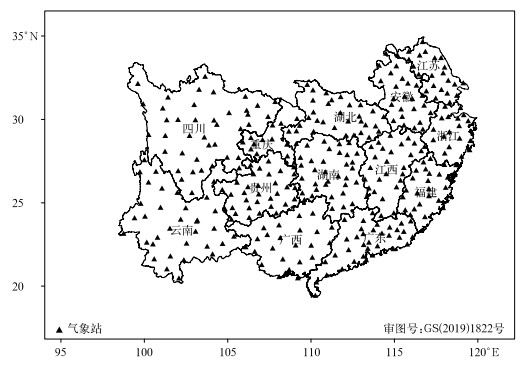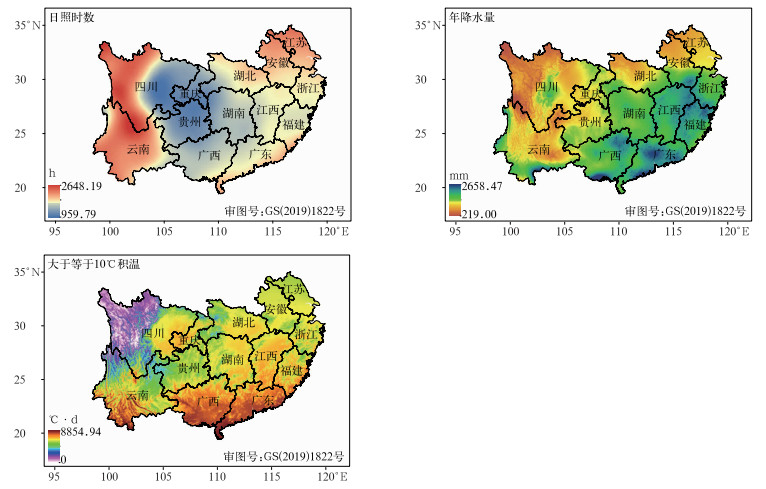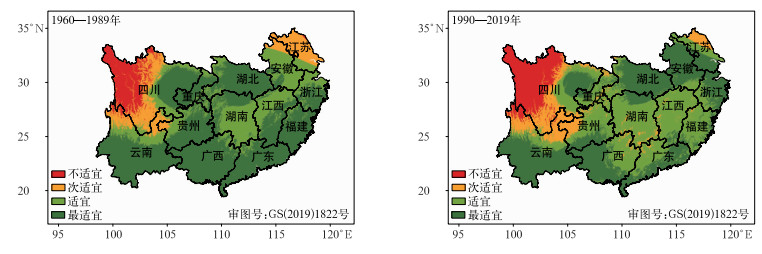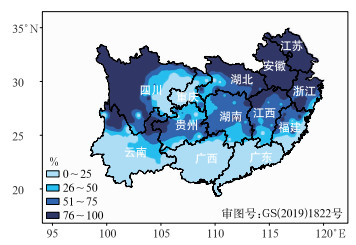Refined Climatic Zoning for Citrus Cultivation in Southern China Based on Climate Suitability
-
摘要: 为探究气候变化对南方柑橘种植气候适宜性的影响,基于气候适宜度函数建立柑橘发育期温度、降水、日照以及综合适宜度模型,对南方柑橘种植区近60年(1960—2019年)361个气象站观测数据进行精细化插值(Anusplin插值)并计算气候适宜度,采用自然断点法分4个等级对柑橘种植区进行气候区划,并分前、后30年对比分析研究区气候资源及适宜度的空间变化特征。结果表明:与前30年相比,后30年的温度适宜度并未出现较大变化,降水适宜度低值区有所扩大,日照适宜度低值区有所减小;柑橘最适宜种植区主要集中于四川东部、云南南部、重庆西北部、广西、湖北大部分区域;最适宜种植区面积减小约29%,不适宜种植区面积扩大约34%。经高温热害及低温冻害概率空间分布验证,区划结果的准确性较高,可以用于指导和优化柑橘种植及生产实践。Abstract: In recent years, global warming leads to the increase of heat resources, the shift of agricultural climatic zones, and the lengthening of crop growing season. These phenomena make citrus often suffer the effects of high temperature heat damage and low temperature freezing damage. At present, the refined climatic zoning of cash crops mainly focuses on tomato, cotton and other crops, but there are few studies involving citrus. Therefore, suitability evaluation model is used to accurately and quantitatively regionalize citrus planting, and to provide a basis for scientific planting and rational distribution of citrus.Using the climate suitability function, the temperature, precipitation, sunshine and comprehensive suitability models of citrus growth period are established. With Anusplin software, the observations of 361 meteorological stations in southern citrus growing region in recent 60 years (1960-2019) are interpolated and the climate suitability is calculated. Then the natural breakpoint method is used to divide the citrus growing area into four levels. The spatial variation characteristics of climate resources and suitability in target area are compared and analyzed in three decades. The results show that most of the regions in target area meet the climatic resources required for the normal growth and development of citrus, and the suitability of temperature, precipitation and sunshine show obvious spatial heterogeneity. The temperature suitability increases from west to east, the precipitation suitability decreases from north to south, the spatial distribution of sunshine suitability is high in the east and low in the west. The suitability of citrus planting is divided into 4 grades: Unsuitability (0 < Fc ≤ 0.17), sub-suitability (0.17 < Fc ≤ 0.36), suitability (0.36 < Fc ≤ 0.48), and most suitability (0.48 < Fc ≤ 0.74). The most suitable areas are mainly in the eastern part of Sichuan, the southern part of Yunnan, the northwestern part of Chongqing, Guangxi and Hubei, and the northwestern part of Sichuan is the unsuitable area. Since 1990, the area of the most suitable planting area has decreased by about 29%, and the area of the unsuitable planting area has increased by 34%. The spatial distribution of high temperature and heat damage and low temperature freezing damage probability verify the accuracy of the zoning results, which can be used to guide and optimize citrus planting and production practice.Different varieties of citrus and site conditions lead to different climate suitability responses. Besides, climate change has obvious impacts on crop planting structure, physiological traits and yield. Therefore, climatic regionalization research on different varieties should be paid more attention especially considering the future climate change scenarios, so as to support the planting and production of citrus.
-
表 1 南方柑橘种植区各发育期时间和温度指标[1, 12, 17, 20]
Table 1 Growth stages and temperature indexes in southern citrus growing area (from Reference [1, 12, 17, 20])
发育期 时段 下限温度tl/℃ 适宜温度t0/℃ 上限温度th/℃ 作物系数Kc 发芽期 02-15—04-10 8.1 14.0 26.0 0.48 花期 04-15—05-10 11.8 20.0 30.0 0.65 生理落果期 05-15—06-15 13.0 21.0 30.0 0.76 果实生长发育期 06-20—10-01 13.0 22.0 34.0 0.95 果实成熟期 10-05—11-10 13.0 21.0 27.0 0.70 花芽分化期 11-20—02-10 -5.0 12.5 23.0 0.39 等级 日最高气温(Tc)及持续时间 轻度 Tc≥37℃持续3~4 d 中度 Tc≥37℃持续5~6 d 重度 Tc≥37℃持续7 d及以上 级别 越冬期极端最低气温Td/℃ 越冬期最长持续降水日数Dr/d 越冬期日最低气温不高于-1.5℃最长持续日数Dc/d 0级 Td>-3 Dr < 2 Dc < 2 1级 -5 < Td≤-3 2≤Dr < 5 2≤Dc < 4 2级 -7 < Td≤-5 5≤Dr < 10 4≤Dc < 6 3级 -9 < Td≤-7 10≤Dr < 15 6≤Dc < 8 4级 -11 < Td≤-9 15≤Dr < 20 8≤Dc < 10 5级 Td≤-11 Dr≥20 Dc≥10 表 4 低温冻害等级划分
Table 4 Classification of low temperature freezing damage
等级 冻害指数I 轻度 6≤I < 11 中度 11≤I < 16 偏重度 16≤I < 21 严重度 21≤I < 26 特重度 I≥26 -
[1] 沈兆敏. 我国柑橘生产现状及未来前景展望. 科学种养, 2019(9): 5-10. https://www.cnki.com.cn/Article/CJFDTOTAL-KXZH201909003.htmShen Z M. The present situation and future prospect of citrus production in China. Scientific Farming, 2019(9): 5-10. https://www.cnki.com.cn/Article/CJFDTOTAL-KXZH201909003.htm [2] 赵彤. 基于GIS的重庆市柑橘农业气候区划. 重庆: 重庆师范大学, 2018.Zhao T. The Study on Agricultural Climate Regionalization of Citrus in Chongqing Province Based on GIS. Chongqing: Chongqing Normal University, 2018. [3] Funes I, Savé R, de Herralde F, et al. Modeling impacts of climate change on the water needs and growing cycle of crops in three Mediterranean basins. Agric Water Manage, 2021, 30(249). https://doi.org/10.1016/j.agwat.2021.106797. http://www.sciencedirect.com/science/article/pii/S0378377421000627 [4] Nadiruzzaman M D, Rahman M, Pal U, et al. Impact of climate change on cotton production in Bangladesh. Sustainability, 2021, 13(2). DOI: 10.3390/su13020574. [5] 张山清, 吉春容, 普宗朝. 气候变暖对新疆杏种植气候适宜性的影响. 中国农业资源与区划, 2019, 40(9): 131-141. https://www.cnki.com.cn/Article/CJFDTOTAL-ZGNZ201909019.htmZhang S Q, Ji C R, Pu Z C. Imact of climate warming on apricot-planting climatic suitability in Xinjiang. Chinese Journal of Agricultural Resources and Regional Planning, 2019, 40(9): 131-141. https://www.cnki.com.cn/Article/CJFDTOTAL-ZGNZ201909019.htm [6] 张山清, 普宗朝, 李新建, 等. 气候变化对新疆苹果种植气候适宜性的影响. 中国农业资源与区划, 2018, 39(8): 255-264. https://www.cnki.com.cn/Article/CJFDTOTAL-ZGNZ201808034.htmZhang S Q, Pu Z C, Li X J, et al. Imact of climate warming on apple-planting climatic suitability in Xinjiang. Chinese Journal of Agricultural Resources and Regional Planning, 2018, 39(8): 255-264. https://www.cnki.com.cn/Article/CJFDTOTAL-ZGNZ201808034.htm [7] 初征, 郭建平. 未来气候变化对东北玉米品种布局的影响. 应用气象学报, 2018, 29(2): 165-176. doi: 10.11898/1001-7313.20180204Chu Z, Guo J P. Effects of climate change on maize varieties distribution in the future of Northeast China. J Appl Meteor Sci, 2018, 29(2): 165-176. doi: 10.11898/1001-7313.20180204 [8] He L L, English B C, Clark C C, et al. Local effects of climate change on row crop production and irrigation adoption. Clim Risk Manag, 2021(32). DOI: 10.1016/j.crm.2021.100293. [9] 林正雨, 陈强, 邓良基, 等. 四川柑橘适宜分布及其对气候变化的响应研究. 中国生态农业学报, 2019, 27(6): 845-859. https://www.cnki.com.cn/Article/CJFDTOTAL-ZGTN201906004.htmLin Z Y, Chen Q, Deng L J, et al. Response of suitable distribution of citrus in Sichuan Province to climate change. Chinese Journal of Eco-Agriculture, 2019, 27(6): 845-859. https://www.cnki.com.cn/Article/CJFDTOTAL-ZGTN201906004.htm [10] 蒋亚平, 张玲玲, 詹莹玉, 等. 基于GIS技术的崇左市宽皮柑橘种植气候区划. 中低纬山地气象, 2019, 43(6): 56-59. doi: 10.3969/j.issn.1003-6598.2019.06.009Jiang Y P, Zhang L L, Zhan Y Y, et al. Climatic regionalization of wide-skinned citrus planting based on GIS technology in Chongzuo city. Mid-low Latitude Mountain Meteorology, 2019, 43(6): 56-59. doi: 10.3969/j.issn.1003-6598.2019.06.009 [11] 王宝, 卢玉娥. 玉溪市柑橘种植气候适宜性分析. 现代农业科技, 2019(21): 80-81. https://www.cnki.com.cn/Article/CJFDTOTAL-ANHE201921041.htmWang B, Lu Y E. Analysis of citrus planting climate suitability in Yuxi city. Modern Agricultural Science and Technology, 2019(21): 80-81. https://www.cnki.com.cn/Article/CJFDTOTAL-ANHE201921041.htm [12] 王道藩. 柑桔与气象. 福州: 福建科学技术出版社, 1986.Wang D P. Citrus and Meteorology. Fuzhou: Fujian Science and Technology Press. 1986. [13] 高莉莉, 常君德, 胡明, 等. 气候适宜度研究综述. 安徽农学通报, 2017, 23(19): 102-103. doi: 10.3969/j.issn.1007-7731.2017.19.051Gao L L, Chang J D, Hu M, et al. A review of climate suitability studies. Anhui Agricultural Science Bulletin, 2017, 23(19): 102-103. doi: 10.3969/j.issn.1007-7731.2017.19.051 [14] 张波, 胡家敏, 谷晓平, 等. 基于气候适宜度的贵州番茄精细化农业气候区划. 北方园艺, 2018(2): 193-198. https://www.cnki.com.cn/Article/CJFDTOTAL-BFYY201802039.htmZhang B, Hu J M, Gu X P, et al. Comprehensive agricultural climate division for tomato in Guizhou Province based on climatic suitability models. Northern Horticulture, 2018(2): 193-198. https://www.cnki.com.cn/Article/CJFDTOTAL-BFYY201802039.htm [15] 齐斌, 余卫东, 袁建昱, 等. 河南省棉花精细化农业气候区划. 中国农业气象, 2011, 32(4): 571-575. doi: 10.3969/j.issn.1000-6362.2011.04.015Qi B, Yu W D, Yuan J Y, et al. Precise comprehensive agricultural climate division for cotton in Henan Province. Chinese Journal of Agrometeorology, 2011, 32(4): 571-575. doi: 10.3969/j.issn.1000-6362.2011.04.015 [16] 王纯枝, 霍治国, 张蕾, 等. 北方地区小麦蚜虫气象适宜度预报模型构建. 应用气象学报, 2020, 31(3): 280-289. doi: 10.11898/1001-7313.20200303Wang C Z, Huo Z G, Zhang L, et al. Construction of forecasting model of meteorological suitability for wheat aphids in the northern China. J Appl Meteor Sci, 2020, 31(3): 280-289. doi: 10.11898/1001-7313.20200303 [17] 杜尧东, 段海来, 唐力生. 全球气候变化下中国亚热带地区柑桔气候适宜性. 生态学杂志, 2010, 29(5): 833-839. https://www.cnki.com.cn/Article/CJFDTOTAL-STXZ201005002.htmDu Y D, Duan H L, Tang L S. Adaptability of citrus in subtropics of China under future climatic scenario. Chinese Journal of Ecology, 2010, 29(5): 833-839. https://www.cnki.com.cn/Article/CJFDTOTAL-STXZ201005002.htm [18] 刘爱华, 叶植材. 中国统计年鉴(2020). 北京: 中国统计出版社, 2020.Liu A H, Ye Z C. China Statistical Yearbook(2020). Beijing: China Statistics Press, 2020. [19] 钱永兰, 吕厚荃, 张艳红. 基于ANUSPLIN软件的逐日气象要素插值方法应用与评估. 气象与环境学报, 2010, 26(2): 7-15. doi: 10.3969/j.issn.1673-503X.2010.02.002Qian Y L, Lü H Q, Zhang Y H. Application and assessment of spatial interpolation method on daily meteorological elements based on ANUSPLIN software. Journal of Meteorology and Environmen, 2010, 26(2): 7-15. doi: 10.3969/j.issn.1673-503X.2010.02.002 [20] 陈尚谟. 果树气象学. 北京: 气象出版社, 1989.Chen S M. Fruit Tree Meteorology. Beijing: China Meteorological Press, 1989. [21] 许昌燊. 农业气象指标大全. 北京: 气象出版社, 2004.Xu C S. Agrometeorological Indicators. Beijing: China Meteorological Press, 2004. [22] 千怀遂, 焦士兴, 赵峰. 河南省冬小麦气候适宜性变化研究. 生态学杂志, 2005, 24(5): 503-507. doi: 10.3321/j.issn:1000-4890.2005.05.008Qian H S, Jiao S X, Zhao F. Climatic suitability change of winter wheat in Henan Province. Chinese Journal of Ecology, 2005, 24(5): 503-507. doi: 10.3321/j.issn:1000-4890.2005.05.008 [23] 鲍江峰, 夏仁学, 彭抒昂. 生态因子对柑桔果实品质的影响. 应用生态学报, 2004, 15(8): 1477-1480. doi: 10.3321/j.issn:1001-9332.2004.08.036Bao J F, Xia R X, Peng S A. Effects of ecological factors on citrus fruit quality. Chinese Journal of Applied Ecology, 2004, 15(8): 1477-1480. doi: 10.3321/j.issn:1001-9332.2004.08.036 [24] 万继锋, 李娟, 杨为海, 等. 柑橘果实响应高温、强光胁迫的活性氧代谢研究. 福建农业学报, 2019, 34(8): 920-924. https://www.cnki.com.cn/Article/CJFDTOTAL-FJNX201908008.htmWan J F, Li J, Yang W H, et al. ROS metabolism of citrus fruits in response to high-temperature-intense-light stress. Fujian Journal of Agricultural Sciences, 2019, 34(8): 920-924. https://www.cnki.com.cn/Article/CJFDTOTAL-FJNX201908008.htm [25] 高阳华, 陈志军, 居煇, 等. 基于GIS的三峡库区精细化甜橙气候生态区划. 西南大学学报(自然科学版), 2009, 31(7): 1-6. https://www.cnki.com.cn/Article/CJFDTOTAL-XNND200907000.htmGao Y H, Chen Z J, Ju H, et al. GIS-based fine climate ecological zoning of sweet orange in the Three Gorges Reservoir area. Journal of Southwest University(Natural Science), 2009, 31(7): 1-6. https://www.cnki.com.cn/Article/CJFDTOTAL-XNND200907000.htm [26] Pereira L S, Paredes P, López U R, et al. Standard single and basal crop coefficients for vegetable crops, an update of FAO56 crop water requirements approach. Agric Water Manage, 2021, 1(243). DOI: 10.1016/j.agwat.2020.106196. [27] 邱美娟, 刘布春, 刘园, 等. 中国北方苹果种植需水特征及降水适宜性. 应用气象学报, 2021, 32(2): 175-187. doi: 10.11898/1001-7313.20210204Qiu M J, Liu B C, Liu Y, et al. Water requirement and precipitation suitability of apple planting in northern China. J Appl Meteor Sci, 2021, 32(2): 175-187. doi: 10.11898/1001-7313.20210204 [28] 吴霞, 王培娟, 陈鹏狮, 等. 黄淮海平原冬小麦最大可能蒸散的估算. 应用气象学报, 2017, 28(6): 690-699. doi: 10.11898/1001-7313.20170605Wu Xia, Wang P J, Chen P S, et al. Estimation of crop evapotranspiration under standard conditions for winter wheat in the Huang-Huai-Hai Plain. J Appl Meteor Sci, 2017, 28(6): 690-699. doi: 10.11898/1001-7313.20170605 [29] 林红, 杨丽霞, 张玉芳, 等. 基于GIS的大英县甜橙种植农业气候区划研究. 中国农学通报, 2016, 32(32): 164-168. doi: 10.11924/j.issn.1000-6850.casb16050142Lin H, Yang L X, Zhang Y F, et al. Agricultural climate division for orange-growing based on GIS in daying. Chinese Agricultural Science Bulletin, 2016, 32(32): 164-168. doi: 10.11924/j.issn.1000-6850.casb16050142 [30] 邓丹丹, 周鹏, 邓龙辉, 等. 奉节县柑橘适宜性评价. 安徽农业科学, 2018, 46(19): 4-8. doi: 10.3969/j.issn.0517-6611.2018.19.002Deng D D, Zhou P, Deng L H, et al. Evaluation of citrus suitability in Fengjie County. Journal of Anhui Agricultural Sciences, 2018, 46(19): 4-8. doi: 10.3969/j.issn.0517-6611.2018.19.002 [31] 胡正月. 柑橘优质丰产栽培300问. 北京: 金盾出版社, 2008.Hu Z Y. Citrus Quality and High Yield Cultivation 300 Questions. Beijing: Jindun Publishing House, 2008. [32] 蒋运志. 阳朔金桔的主要气象灾害分析及防御. 南方园艺, 2010, 21(5): 10-13. doi: 10.3969/j.issn.1674-5868.2010.05.005Jiang Y Z. Analysis and prevention of main meteorological disasters of kumquat in Yangshuo. Southern Horticulture, 2010, 21(5): 10-13. doi: 10.3969/j.issn.1674-5868.2010.05.005 [33] 杨凯, 陈彬彬, 陈惠, 等. 福建省台湾青枣寒害综合气候指标与等级划分. 应用气象学报, 2020, 31(4): 427-434. doi: 10.11898/1001-7313.20200405Yang K, Chen B B, Chen H, et al. Comprehensive climatic index and grade classification of cold damage for Taiwan green jujube in Fujian. J Appl Meteor Sci, 2020, 31(4): 427-434. doi: 10.11898/1001-7313.20200405 [34] 杨建莹, 霍治国, 王培娟, 等. 江西早稻高温热害发生时间分布特征. 应用气象学报, 2020, 31(1): 42-51. doi: 10.11898/1001-7313.20200104Yang J Y, Huo Z G, Wang P J, et al. Occurrence characteristics of early rice heat disaster in Jiangxi Province. J Appl Meteor Sci, 2020, 31(1): 42-51. doi: 10.11898/1001-7313.20200104 [35] 柏秦凤, 霍治国, 王景红, 等. 中国主要果树气象灾害指标研究进展. 果树学报, 2019, 36(9): 1229-1243. https://www.cnki.com.cn/Article/CJFDTOTAL-GSKK201909013.htmBai Q F, Huo Z G, Wang J H, et al. Progress in research on meteorological disaster indicators of major fruit trees in China. Journal of Fruit Science, 2019, 36(9): 1229-1243. https://www.cnki.com.cn/Article/CJFDTOTAL-GSKK201909013.htm [36] 杨爱萍, 杜筱玲, 王保生, 等. 江西省多气象要素的柑橘冻害指标. 应用气象学报, 2013, 24(2): 248-256. doi: 10.3969/j.issn.1001-7313.2013.02.013Yang A P, Du X L, Wang B S, et al. The multiple-meteorological-factor indexes for orange frozen injury in Jiangxi Province. J Appl Meteor Sci, 2013, 24(2): 248-256. doi: 10.3969/j.issn.1001-7313.2013.02.013 [37] 彭艳玉, 刘煜, 缪育聪. 温室气体对亚洲夏季风影响的数值研究. 应用气象学报, 2021, 32(2): 245-256. doi: 10.11898/1001-7313.20210209Peng Y Y, Liu Y, Miao Y C. A numerical study on impacts of greenhouse gases on Asian summer monsoon. J Appl Meteor Sci, 2021, 32(2): 245-256. doi: 10.11898/1001-7313.20210209 [38] 查书平, 陈志军, 高阳华, 等. 基于GIS的重庆地区实际日照时间空间分布研究. 气象科学, 2008, 28(5): 548-551. doi: 10.3969/j.issn.1009-0827.2008.05.013Cha S P, Chen Z J, Gao Y H, et al. Research of spatial distribution of real sunshine hours based on GIS in Chongqing. Journal of the Meteorological Sciences, 2008, 28(5): 548-551. doi: 10.3969/j.issn.1009-0827.2008.05.013 [39] 王玉洁, 周波涛, 任玉玉, 等. 全球气候变化对我国气候安全影响的思考. 应用气象学报, 2016, 27(6): 750-758. doi: 10.11898/1001-7313.20160612Wang Y J, Zhou B T, Ren Y Y, et al. Impacts of global climate change on China's climate security. J Appl Meteor Sci, 2016, 27(6): 750-758. doi: 10.11898/1001-7313.20160612 [40] 魏兴萍. 基于格网的重庆市柑橘种植气候区划. 重庆工商大学学报(自然科学版), 2009, 26(3): 302-304. doi: 10.3969/j.issn.1672-058X.2009.03.021Wei X P. Climate district of orange planting in Chongqing based on grid net. Journal of Chongqing Technology and Business University(Natural Science), 2009, 26(3): 302-304. doi: 10.3969/j.issn.1672-058X.2009.03.021 [41] 谭宗琨, 罗增桂, 王璟. 广西'沃柑'果实品质等级气候适宜性种植区划研究. 中国农学通报, 2021, 37(5): 65-74.Tan Z K, Luo Z G, Wang J. Climatic suitability planting regionalization of Orah's fruit quality grade in Guangxi. Chinese Agricultural Science Bulletin, 2021, 37(5): 65-74. -


 设为首页
设为首页 加入收藏
加入收藏



 下载:
下载:







